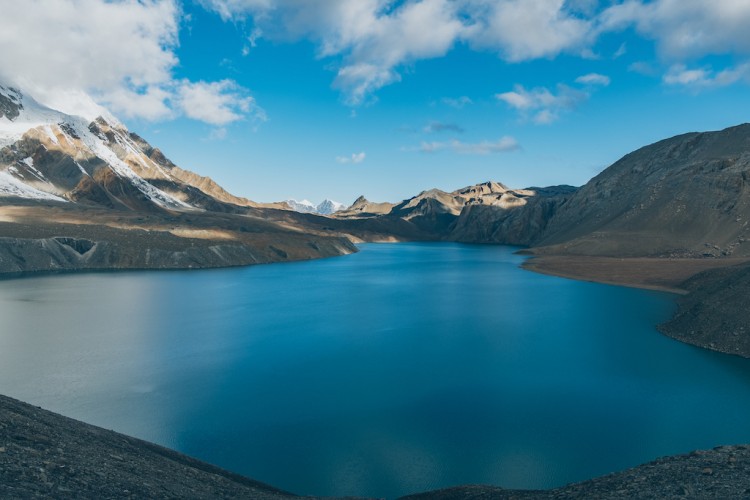TIPS FOR PHOTOGRAPHING THE ANNAPURNA CIRCUIT
( )
)
Photographing the Annapurna Circuit Tilicho Lake after sunrise. Photo:
The Annapurna Circuit offers one of the most breathtaking mountain landscapes in the world, meaning that during the trek you will have plenty of chances to capture fantastic moments, unique experiences and beautiful scenery.
Some of the following recommendations may look like photography common sense, but I wish I had known them before I trekked the circuit.
BE FIT
Does fitness have anything to do with photography opportunities? It does: the trek is tough, and you should be prepared for 6 to 8 hours walking. You’ll need to carry your camera gear, which can be heavy after 4 hours of walking. If you are not used to walking up hills, start training before you trek, and preferably on a regular basis. Getting used to your backpack and boots is very important. As an option, you could hire a porter to carry your clothes backpack, and you just need to carry your camera gear.
BE RESTED AND EAT WELL
After a long day trekking, you’ll feel tired. It’s difficult to avoid that, but you can face it differently if you sleep enough and eat properly. Food is essential while trekking, so don’t skip a meal.
PHOTOGRAPHY GEAR
Everything you carry adds up in your heavy backpack. So I would say versatility takes priority here, unless you’re on a photo workshop or expedition.
The basics are: camera body, wide-angle lens (10–24mm) and a telephoto zoom lens (70–200mm). With those, you will be able to cover the majority of the landscapes and people who live high in the mountains. You can choose to carry a third lens, like a 35mm, or instead choose a lense “for everything”, like a 18–135mm.
I would say two lenses are enough, as during the trek you’ll not be changing lenses all the time. I carried three Fuji X-mount lenses, the 16mm, 18–55mm, and 55–200mm.
To the above, add a tripod for low light and night, and a polarizing filter to improve contrast and make the colors pop.
Lastly, keep whatever gear you have protected from the rain, snow and cold, and bring extra batteries too.
LOCATIONS
Here are my favourite locations for taking photos on the Annapurna Circuit (although this is not an exhaustive list of great places):
At the beginning of the trek, from Syange to Dharapani, there are very green landscapes full of waterfalls.
Dharapani is where you’ll see the first high mountain of the trek, Manaslu.
Although I didn’t overnight here, I think Upper Pisang has the best views of Annapurna II.
From Ghyaru–which I believe is the nicest village on the trek–you will have an incredible panoramic view of Annapurna II & III.
From Manang there are excellent views of the Gangapurna Glacier.
Although Tilicho Lake is considered a side trip, it’s an incredible site for photography, especially during ascension and the lake glacier.
Wherever you decide to do overnight, look for a place with a rooftop terrace. I found this very important, as it allowed me to be up high enough to avoid obstacles.
GET YOUR TIMING RIGHT
This sounds obvious, but it isn’t always followed: wake early for sunrise and stay for sunset if you want to get the best lighting conditions.
In my opinion, sunrises were better on the Annapurna Circuit, as every morning their were either few clouds or almost none. Almost every sunset was overcast, which wasn’t good for capturing the light, or getting night shots. It’s important to know the weather conditions, so ask the locals or try to get the forecast. Waking up early can get you better photos.
A couple of apps are really helpful for planning when to take photos. Sun Surveyor or PhotoPills will tell you everything about the sun and magic hours, when the moon rises and sets, moon phases, nights where the Milky Way is showing, or when there’s total darkness.
Shooting during the harsh light of midday is also worthwhile, but I found that my best pictures were those taken at sunset, sunrise and night.
KEEP YOURSELF MOTIVATED
Most of the time I go out with my camera I’m very motivated to take pictures. However, the Himalayas were incredibly challenging to me, both physically and mentally. You can become tired after a long day hiking, or cold, or have trouble with the altitude. These things happened to me, and it became difficult to keep up. My advice is to be alert, flexible and patient. Most importantly of all, always stay positive and have fun!
followed and upvoted
P.S: this fooking cheetha detetcts copy and paste content
Haha take it easy i was just advising my friend to write a original post so that the ceetha doesnot catch you else it will fook you up
@cheetah is here to expose you plagiarists who steal other people's work to earn few cents. @cheetah is a friend of good productive people on steemit. If you have no respect for the community you are in, you are the one who should be fooking out of this place.
Very Nice Job bro!
Thank yuh bruh!